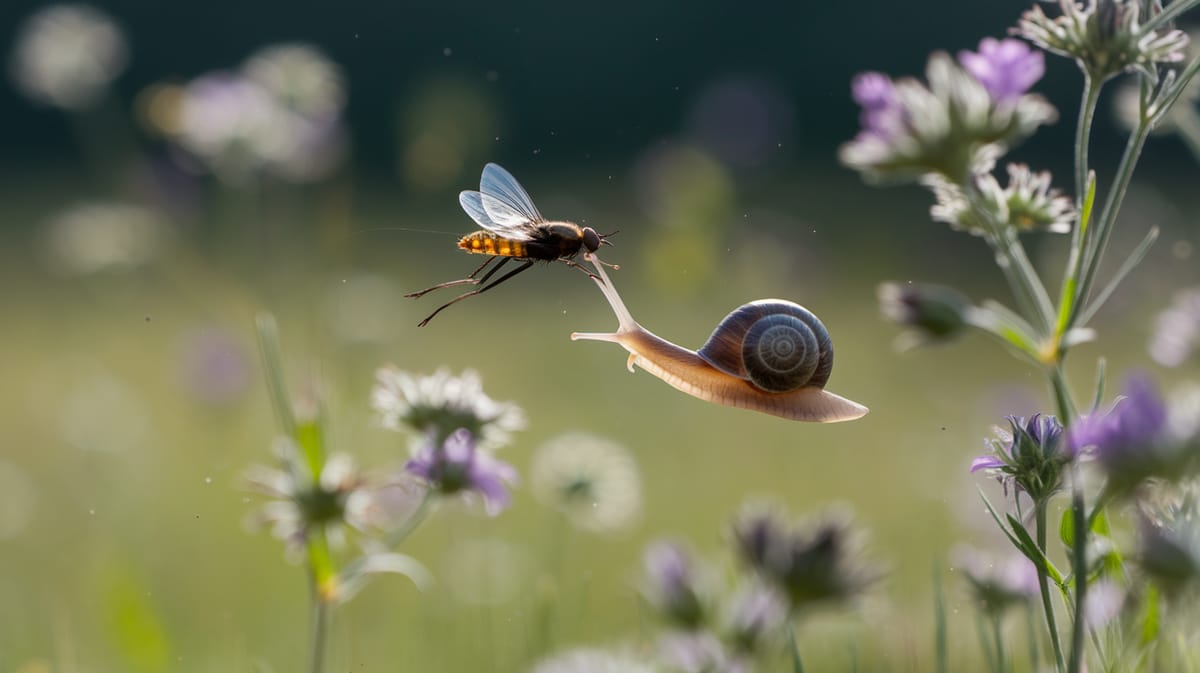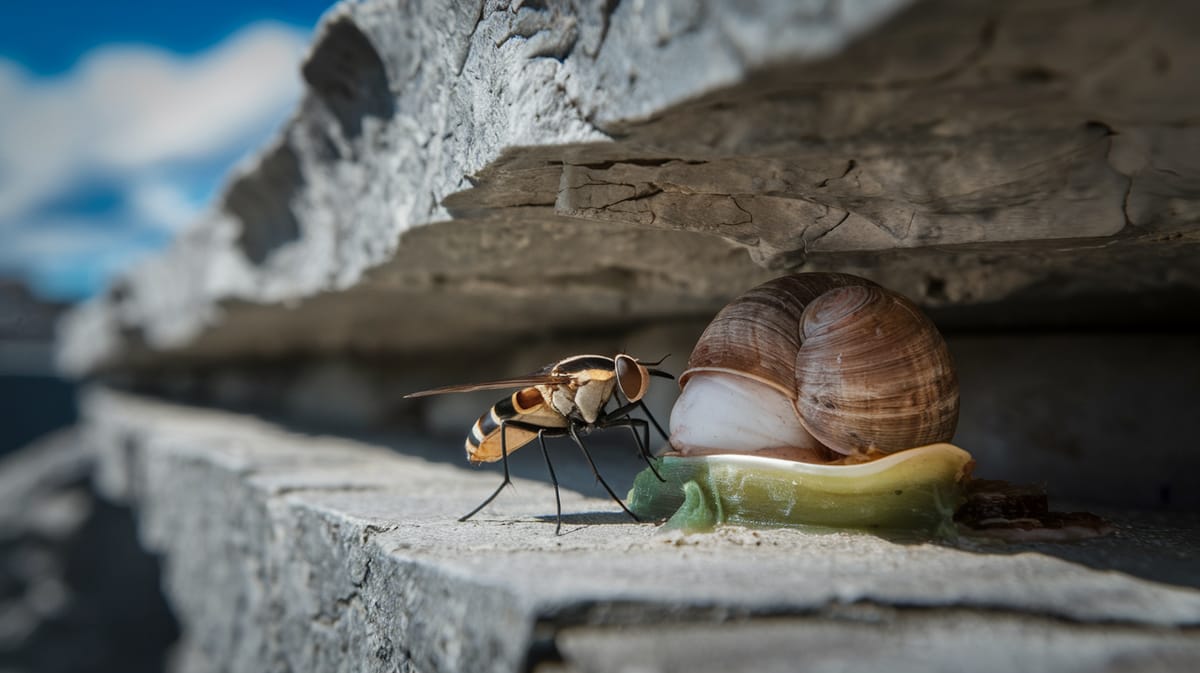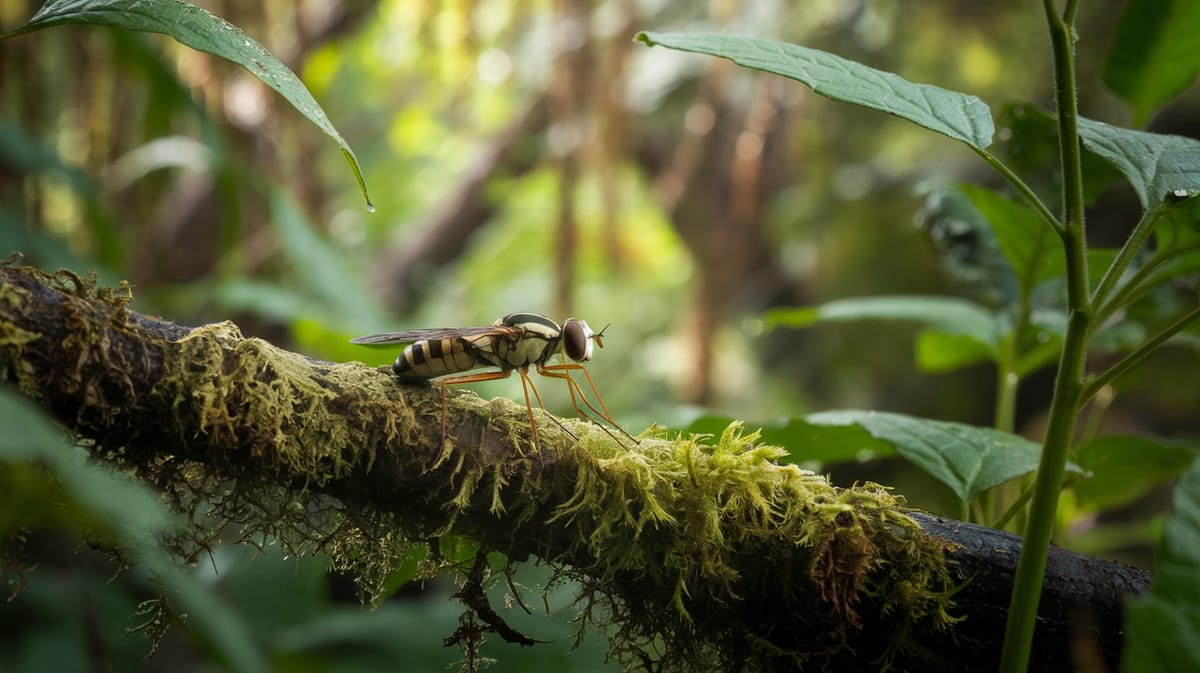Snail Killing Flies
Swift hunters of the mollusk world, Snail Killing Flies excel in parasitizing snails with precision. Their larvae play a significant role in controlling snail populations.

Key Insights at a Glance
Did You Know?
Taxonomy & Classification
Snail Killing Flies exhibit unique adaptations for mollusk predation, with a specialized larval stage that targets snails, marking a fascinating evolutionary niche. Let's understand the evolutionary journey and classification of these remarkable predators.
Global Reach
Present in over 535 species, these flies inhabit diverse regions, thriving in various ecosystems across the globe.
Evolutionary Adaptations
Originating around 66 million years ago, they evolved specialized larval predation to exploit snail populations effectively.
Lifecycle and Growth
A remarkable journey of transformation from Egg to Adult.
Egg
Laid in moist environments, eggs hatch quickly, releasing larvae primed to hunt snails and slugs for sustenance.
Larva
Larvae actively pursue and consume snails, a crucial feeding phase that supports their rapid growth and development.
Pupa
Encased in protective puparia, pupae undergo significant transformation, preparing to emerge as adult flies.
Adult
Equipped with specialized mouthparts, adults focus on reproduction, continuing the cycle and ensuring population stability.
Dietary Habits
An efficient hunter with exclusive dietary focus, this insect primarily targets snails, using specialized adaptations to subdue and consume its prey.
| DIET TYPE | DESCRIPTION |
|---|---|
| Primary Diet | Primarily feeds on terrestrial snails, employing a unique method to extract and consume the soft tissues. |
| Secondary Diet | Occasionally targets other mollusks, such as slugs, expanding its dietary range when snails are scarce. |
| Occasional | Rarely consumes small insects or detritus, relying on these sources only when other options are unavailable. |

Behaviour and Adaptations
Discover the remarkable capabilities that make Snail Killing Flies adept predators of snails.
Precision Oviposition
Females deposit larvae precisely near snail hosts for optimal development.
Larval Parasitism
Larvae feed on live snails, ensuring high survival rates.
Specialized Mandibles
Adapted mandibles efficiently pierce snail shells.
Ecosystem Impact
Snail Killing Flies contribute significantly to ecosystem stability by controlling snail populations and supporting biodiversity.
Natural Pest Control
Prey on snails and slugs, reducing pest populations and supporting agriculture.
Biodiversity Support
Provide food for birds and other predators in their ecosystem.
Disease Control
Help limit snail-borne disease transmission by curbing snail numbers.
Conservation Challenges
Understanding and addressing the major threats to Snail Killing Flies populations.
Habitat Loss
Urbanization and agriculture reduce available habitats for Snail Killing Flies.
Pesticide Exposure
Widespread pesticide use threatens survival by contaminating food sources.
Climate Change
Altered weather patterns disrupt breeding and feeding cycles.
Frequently Asked Questions
How long do Snail Killing Flies live?
Snail Killing Flies generally live for about two weeks as adults. Their lifecycle includes several stages: egg, larva, pupa, and adult. Environmental factors like temperature and availability of food can influence their lifespan.
What do Snail Killing Flies eat?
As larvae, Snail Killing Flies feed on snails and slugs, which they parasitize. Adult flies consume nectar and other sugary substances, which provide them with the necessary energy for survival and reproduction.
Are Snail Killing Flies poisonous?
Snail Killing Flies are not poisonous to humans or pets. Their larvae are specialized predators of snails and slugs, and they pose no threat to larger animals or humans.
Are Snail Killing Flies endangered?
Snail Killing Flies are not considered endangered. They are found in various regions, and their populations are stable due to their adaptability to different environments and their role in controlling snail and slug populations.
What do Snail Killing Flies symbolize?
Snail Killing Flies typically symbolize transformation and change due to their parasitic nature on snails and slugs. They play a role in natural pest control, which can also symbolize balance and ecological harmony.
Do Snail Killing Flies bite?
Snail Killing Flies do not bite humans or animals. Their mouthparts are not designed for biting. Instead, they feed on nectar as adults, while their larvae target snails and slugs.
What color are Snail Killing Flies?
Snail Killing Flies are usually dark in color, often black or dark brown. Some species may have lighter markings. Their coloration helps them blend into their surroundings, providing camouflage from predators.
Does a Snail Killing Flies have wings?
Yes, Snail Killing Flies have wings. As adults, they are fully capable of flight, which aids in their search for food sources and suitable environments to lay their eggs.
What does a Snail Killing Flies look like?
Adult Snail Killing Flies are small and dark-colored, resembling houseflies but with distinct features. They have slender bodies, clear wings, and sometimes lighter markings. Their larvae, which target snails, are maggot-like in appearance.
Is a Snail Killing Flies an insect?
Yes, Snail Killing Flies are insects. They belong to the order Diptera, which includes all true flies. Like other insects, they have a three-part body structure: head, thorax, and abdomen, and six legs.
Related Insects
Discover insects with similar characteristics to Snail Killing Flies - including shared habitats, diets, and taxonomic classifications
Share this profile
Help others discover Snail Killing Flies
